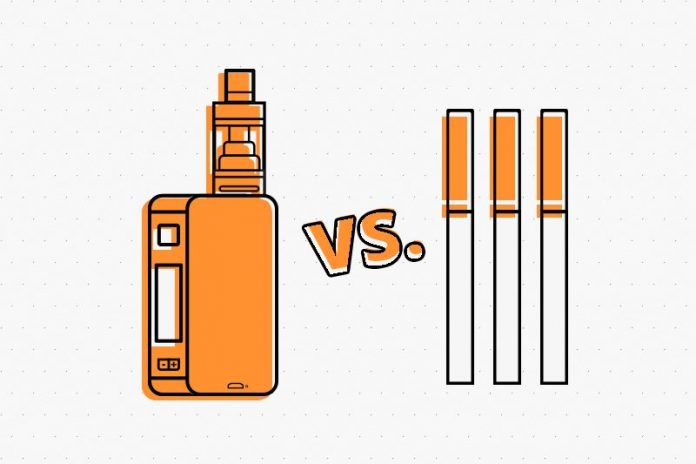Vaping vs. Cigarettes
October 9, 2018
Teenage rebellion and angst has manifested itself in several forms over the decades. Most notable of these forms were the Greasers of the fifties and sixties, who wore leather jackets as well as held grudges against authority on their shoulders. Cigarettes hung loosely from their apathetic mouths, a habit learned at a young age that would lead to health problems in the long run, as nicotine creates a firm grip on it’s victims that refuses to let go. These days, not much has changed. Teenagers still smoke a variety of drugs in order to be a part of the in-crowd, but the most popular by far would be vapes and JUULs.
The term E-cigarettes sums up what they are— an electronic cigarette that can be charged instead of burned, and that emits water vapor instead of smoke. The term “water vapor” may sound more innocent than the term “smoke,” as everyone knows that cigarette smoke carries tar, carbon monoxide and other lethal toxins. However, vape vapor also contains the same chemical as cigarettes that gives them their addicting quality: nicotine. Vapes contain nicotine to pull in new users just like cigarettes do, which is bad news for teens looking for a new, “innocent” fad to buy into.
Interestingly enough, E-cigarettes were created to help current smokers try a better alternative to cigarettes in the name of quitting the habit. According to Scientific American, between the e-cigarette being patented for the first time in the 1960s to 2018, the amount of cigarette smokers in America has dropped by eight million people. While this drop in popularity is largely thanks to government-funded programs against drugs, it’s hard to ignore the role that vaping has played in the recent years. Smokers who try to lay off the habit of smoking often move one step down to vaping as a better way to get their nicotine fix while also kicking their cigarette habit. Even if the smoker did not quit nicotine completely, then at least they would be smoking flavored water vapor instead of the chemical equivalent to car exhaust. Unfortunately vapes have found a new target audience completely, which is posing a health risk to the young generation of today.
Recent studies have shown that vapes are not as “healthy” as most may think. Scientists in the American Lung Association have raised concerns over the artificial flavoring in the vapor, which may be responsible for a lung disease called “Popcorn Lung”, scarring the lungs’ smallest branches, causing shortness of breath and coughing. In fact, the symptoms of Popcorn Lung closely mimic those of Chronic Obstructive Pulmonary Disease (COPD). Cigarette smokers most commonly fall to COPD, as cigarette smoking is the leading cause. Other concerns fall over the other various ingredients of vapes, which can include lead and formaldehyde, among other chemicals. Overall, vapes are too new of a technology for anyone to really know the consequences of habitual use. Today’s teenagers will serve as guinea pigs for the future, as humanity will learn from the mistakes of the past, similarly like how the world reacted to cigarettes becoming one of the largest and most preventable causes of death.
The mid-1900s was an era of backwardness in American culture. Young adults walked around presumming that they knew more than the adults around them. The same practice occurs today as the young generation becomes addicted to vaping ignoring the cautions from the adults who survived smoking habits, lung cancer and emphysema who beg them to stop. The young generation insists that this is the cool thing to do, the modern way to have fun, to destroy their lungs and neurochemical build-up and make themselves addicted, always craving more.
Despite the common sense and guidance of the adults around them, teenagers today still manage to convince themselves and their peers that the self-destructive practice of vaping is worth the social gratification.































